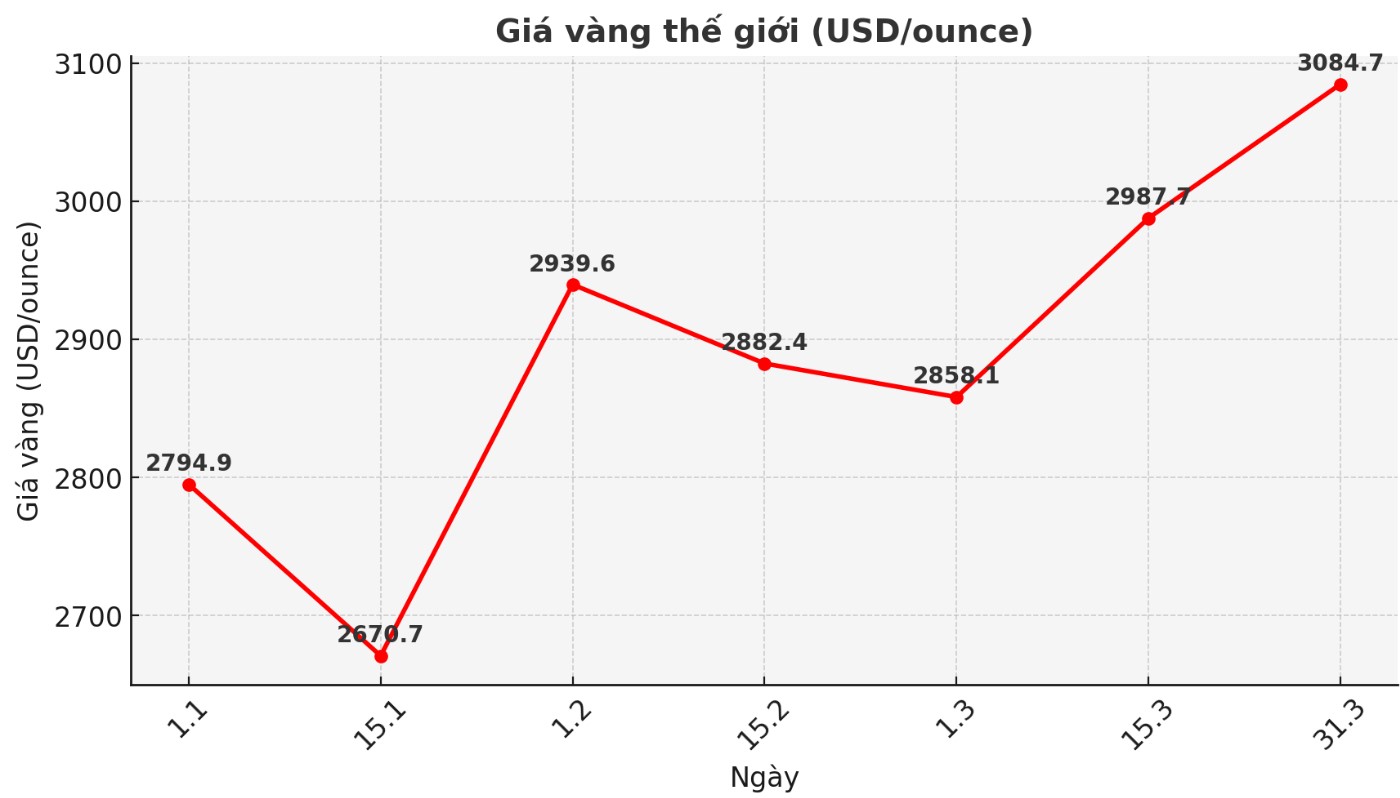Looking back at gold price developments in the first quarter of 2025
The first three months of 2025 were marked by major fluctuations in the gold market, as the precious metal continuously set new records. As of the end of the first quarter of 2025, spot gold prices have reached $3,117/ounce, the highest ever. Meanwhile, spot silver prices surpassed the important resistance level of $35/ounce.
Gold prices increased sharply in the first quarter of 2025 due to many supporting factors, from safe-haven asset demand to economic fluctuations and signs of inflation. Many countries are facing high interest rates and slowing growth, causing a wave of investment in gold as a channel for asset preservation.
The consumer price index (CPI) of many countries over the past 5 years has exceeded 23%, causing gold prices to maintain a strong increase. Economic forecasts show GDP growth in 2025 to only 1.7%, while inflation could reach 2.8%.
The global financial market is witnessing a strong shift in capital flows into gold. Investors are increasingly concerned about central banks' ability to control inflation.
In this context, the precious metal has become a top choice, pushing prices to an all-time high. The demand for physical gold has also increased sharply, especially in Asian economies, where people consider gold a safe haven for accumulating assets during times of fluctuations.

Another factor that contributes to boosting gold prices is the increase in gold ETFs. According to Bloomberg data, the cash flow into gold ETFs in the first quarter of 2025 reached its highest level since 2020. As institutional investors increase their gold position in their portfolios, buying pressure continues to strengthen the upward trend of the precious metal.
Gold prices also benefited from the weakening of the USD. In recent weeks, the DXY index measuring the strength of the US dollar against a basket of major currencies has declined, creating conditions for gold to increase in price more strongly.
The USD-gold ratio remains unchanged in 2025, as the market predicts the US Federal Reserve (FED) may have to adjust monetary policy to cope with a slowing economy.
Gold price prospects in the coming time
Technically, gold has surpassed $3,000 an ounce and is now likely to continue its rally to $3,336 an ounce, calculated based on the Fibonacci Extension principle (a popular tool in technical analysis, helping to predict what prices assets could reach based on previous trends).
Meanwhile, important support levels are $3,000/ounce, $2,950/ounce and $2,795/ounce, respectively.
According to Kitco, the Relative Strength Index (RSI) on the monthly time frame has reached 83, showing that gold is in the overbought zone. This means that there have been too many gold buyers recently, increasing the likelihood of a short-term price adjustment.
However, in terms of long-term trends, gold is still in a strong uptrend. If after a small correction, prices remain above important support levels, the uptrend may continue, and gold is likely to reach higher levels in the future.

Data from the World Gold Council (WGC) shows that central bank gold purchases will remain high in the first quarter of 2025. This trend started in 2022 and has not shown any signs of decline, as many countries continue to increase gold reserves to reduce dependence on the USD.
Market sentiment towards gold remains positive, as experts predict gold prices could continue to conquer higher levels. ANZ Bank recently raised its gold price forecast to $3,500/ounce by the end of 2025, based on expectations of safe-haven demand and a weakening of the global economy. Several other organizations such as Goldman Sachs and JPMorgan also said gold is still in a solid uptrend.
In addition, the gold market is also supported by buying activities of individual investors. In India and China, the world's two largest gold consuming markets, demand for jewelry and gold bars has recovered strongly after a period of decline in 2023. Meanwhile, in the US and Europe, gold investment funds continue to increase their holding ratio to protect their portfolios from economic risks.
With strong growth, gold could head towards $4,000/ounce in the long term. For gold to enter a new boom phase, prices need to hold steady above the support level of 2,800 USD/ounce and maintain strong demand from investors. With unpredictable fluctuations in the second quarter, gold will still be the most closely monitored asset in the coming time.










